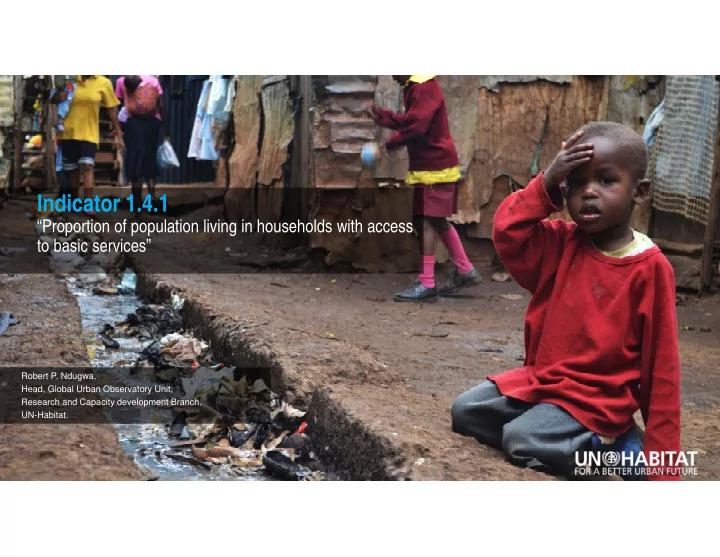

Indicator 1.4.1 “Proportion of population living in households with access to basic services” Robert P. Ndugwa, Head, Global Urban Observatory Unit, Research and Capacity development Branch, UN-Habitat.
Background and international standards • This indicator is dependent on many other existing SDG indicators • The concepts and applicable data principles thus rely on existing international standards, which have been developed and tested for more than 20 years What is “Basic Services”? Safe drinking water Improved Solid waste Transport & mobility Modern energy sanitation collection ICT Social welfare Health care Education Public and open space 2
Visualization
NSO and expert consultations During these EGMs; EGMs held between 2016 and 2017 • Consulted experts included : NSOs, city teams, regional bodies, international experts, CSO and experts working on poverty and access to • Methodology development started with the review of various basic services. basic services. • NSOs were consulted on methodology, feasibility and data collection tools • The first high level expert group discussion was held in Dec (e.gs Colombia, India, Jamaica, Tanzania, Uganda, Cameroon, USA, 2016 followed by March 2017 Belgium, Brazil, Colombia, Democratic Republic of Korea, Mexico, Netherlands, Rumania, Spain, United Arab Emirates, Uganda, Africa • Monthly consultations by a group of experts for specific basic Centre for Statistics/UNECA) services from diverse professional backgrounds and agencies • Other experts included regional bodies (African Regional Institute for to review and refine the metadata followed Geospatial Information Science and Technology, Union of Arab • The final expert group meeting was held in May 2017. surveyors, Regional Center for Mapping and Resources Development - RCMRD), UNGGIM and other UN bodies (WHO, UNICEF and UNDP) A capacity assessments survey with 17 NSOs was undertaken, which was followed by bilateral consultations and administrative data reviews Following the consultations, methodological work for this indicator was completed in October 2017.
Discussions on method of computation The indicator computations discussed two stages , applied depending on the level at which data is collected. Access to basic drinking water Access to energy services Individual components of access to basic services Waste Access to basic Access to ICT Access to open collection sanitation services public spaces are computed first, services services Step 2 followed by an Step 1 aggregation of the Access Access to components with no education social welfare Access to basic Access to basic mobility Hygiene weights. services services Access to healthcare Computing metrics for other components Getting proportion of population with access to that are not measured at the household level ALL the basic services from primary data e.g. access to health, education, transport, sources e.g. HH surveys and census. using data from modern sources e.g. GIS ��. �� ������ ���� ������ �� ��� ��� ����� �������� Proportion of Population with access to basic services � ��� ����������
5 Basic services markers These 5 basic services markers were agreed upon through expert and NSO consultations; Basic Sanitation Basic Waste Basic Hygiene Basic Drinking Basic Mobility Services Facilities Collection Services Water Services (definition and (definition and (definition and (definition and (definition and standards based on standards based on standards based on standards based on standards based on SDG 9.1.1 and 11.2.1) SDG 6.2.1) SDG 11.6.2) SDG 6.2.1) SDG 6.1.1) ��. �� ������ ���� ������ �� ��� ��� ����� �������� Proportion of Population with access to basic services � ��� ���������� 6
Feedback from consultations 1 st High level expert group • Refinements to the indicator methodology and a substantially updated Metadata discussion document 2 nd High level expert • Experts from various backgrounds and agencies met on a monthly basis and refined the group meeting Metadata, until consensus was reached in late May. • Computation of data points for relevant variables for this indicator for several countries on a pilot basis. UN Habitat with NSO • Results of the pilot studies and list of countries consulted that are regionally representative have been compiled into a database with 150 countries • 80% of the indicator relevant questions are available in major household survey programs Global Surveys such as LSMS and DHS, and MICS • Confirmed that the indicator data can be collected through global survey modules , NSO Consultants although some targeted technical assistance may be needed in the earlier stages • Consensus reached: • “an aggregated value works as the best measure to inform policies of regions where the most Consultations and country level piloting with NSOs deprivations are prevalent, but is not actionable. Instead, the individual component measurements point rightly to areas of improvements or investments”
Selected countries with data for 1.4.1
Conclusions • The indicator methodology has been finalized , in partnership with NSOs and other partners and disseminated for application globally • Data points were generated for select countries , and a database containing relevant data from 150 countries has been compiled • Training modules on the methodology developed and disseminated to all NSOs • Data collection for indicator will be possible through a variety of regular surveys, availing up to date and disaggregated data more frequently • The concepts used in this indicator are based on other well developed indicators which were endorsed by the IAEG-SDGs.
Thank You
Recommend
More recommend